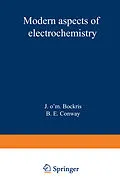The first chapter in the present volume takes up a well-known theme in modern context: the ideas concerning non-Stokesian mechanisms of ion transport. We are happy that one of the great pioneers of modern electrochemistry, T. Erdey-Gniz, in collaboration with S. Lengyel, has consented to write this article for us. Along with it is a solution-oriented article in spectroscopic vein, namely, that by A. Covington and K. E. Newman on the analysis of solution constituents by means of nuclear magnetic resonance studies. Progress in the electrochemistry of the double layer has perked up, and the advances have been triggered from critical experiments, one showing that fluoride ions are specifically adsorbed, and the other showing that the position of maximum disorder of the water molecules occurs at a charge opposite to that needed for interpreta tions of capacitance humps in terms of water molecules. M. A. Habib, who has contributed to the theory in this area, reviews the con sequences of these changes in information. The rise in the price of energy toward a situation in which sources other than the fossil fuels become economical implies much for the fuel cell and electrocatalysis. It has long been known that electrocatalysis in real situations was more than a consideration of exchange current densities, and a gap remains in the formulation of the theory of supports for such catalysts, although Boudart has stressed so much the vital nature of them. P. Stonehart and K. A. Kinoshita describe progress in this area.
Inhalt
1 Proton Transfer in Solution.- I. Introduction.- II. Experimental Findings.- 1. Anomalous Mobility of Ions of the Solvent Molecule in a One-Component Solvent.- 2. Effect of Structural Changes on Proton-Transfer Mobility.- III. Theories of Abnormal Conductance.- 1. Theories Reviewed by Conway.- 2. Recent Suggestions in the Theory of Abnormal Conductance.- 3. A Semiempirical Theory of the Average Size of Clusters in Water.- 4. The Quantum Mechanical Theory of Weidemann and Zundel.- 5. Theories Rejecting Proton Transfer.- IV. The Theory of the Contribution of Transfer Reactions to Transport Processes.- V. Concluding Comments.- References.- 2 NMR Studies of the Structure of Electrolyte Solutions.- I. Introduction.- II. General Principles.- 1. Shift Measurements.- 2. Linewidth and Relaxation Phenomena.- III. Studies on Solvents and Solvent Mixtures.- 1. Structure of Water.- 2. NMR Studies of Water.- 3. Interaction of Organic Molecules with Water.- IV. NMR Studies of Electrolyte Solutions.- 1. Aqueous Solutions.- 2. Nonaqueous Solutions.- 3. Mixed Solvents.- V. Concluding Remarks.- References.- 3 Solvent Dipoles at the Electrode-Solution Interface.- I. Introduction.- II. Experimental Information on Solvent Properties.- 1. Solvent Excess Entropy.- 2. Entropy of Formation of the Double Layer.- III. Models of Water in the Interface.- 1. The Two-State Water Model.- 2. The Three-State Water Model.- 3. Solvent Excess Entropy: Modelistic Approach.- 4. The Four-State Water Model.- IV. Influence of the Metal on the Solvent Properties.- 1. Introduction.- 2. Dependence of Some Electrochemical Properties on the Nature of the Substrate Metal.- V. Discussion and Conclusion.- References.- 4 Preparation and Characterization of Highly Dispersed Electrocatalytic Materials.- I. Introduction.- II. Electrocatalyst Supports.- 1. Carbon.- 2. Other Supports.- 3. Electrocatalyst-Support Interactions.- III. Preparation of Electrocatalysts.- 1. Impregnation.- 2. Ion-Exchange and Adsorption.- 3. Colloidal Electrocatalyst Particles.- 4. Adams' Method.- 5. Raney's Method.- 6. Thermal Decomposition.- 7. Freeze-Drying.- 8. Binary Alloy Catalysts.- IV. Characterization of Electrocatalysts.- 1. Adsorption Methods.- 2. X-Ray Analysis.- 3. Electron Microscopy.- 4. Reaction-Rate Measurements.- V. Summary.- References.- 5 Charge-Transfer Complexes in Electrochemistry.- I. Theoretical Introduction.- 1. Charge-Transfer Complexes.- 2. Donors, Acceptors, and Complexation.- 3. Weak Charge-Transfer Complexes.- 4. Strong Charge-Transfer Complexes.- II. Solid Charge-Transfer Complexes.- 1. Crystal Structures.- 2. Electrical and Magnetic Properties.- 3. Modes of Charge Transfer in the Solid State.- 4. Tetracyanoquinodimethan Salts.- III. Identification of Charge-Transfer Complexes.- 1. Spectroscopy.- 2. Conductimetric Titrations.- 3. Dielectric Properties.- 4. Other Electrical and Magnetic Methods.- IV. Biological Applications.- 1. Introduction.- 2. Charge-Transfer Interactions on Biological Membranes.- 3. Charge-Transfer Complexes and Drug Activity.- 4. Charge-Transfer Complexes in Biological Energy Transfer.- 5. Charge-Transfer Complexes and Carcinogenesis.- 6. Enzymatic Charge-Transfer Complex Reactions.- References.
